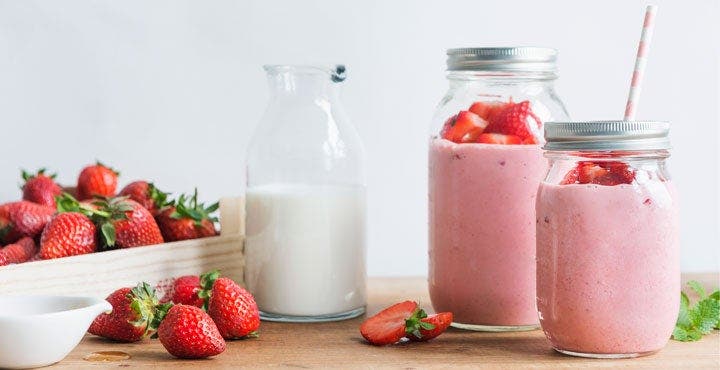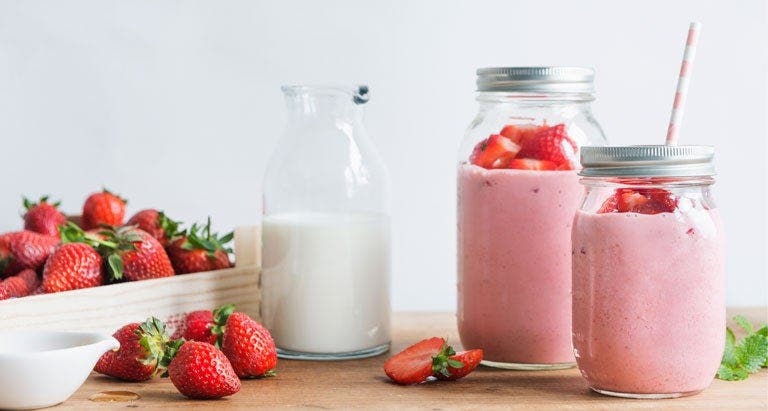Why smoothies beat ice cream for summer


For years, ice cream was the perfect summertime treat. Then came the smoothie, a seemingly lighter, healthier, fruit-based alternative.
If you’ve ever wondered which one is the smarter pick, look no further. We’ve put these frozen goodies head-to-head. For a level playing field, we compared the smallest serving size of each, facing off a half-cup of full-fat Häagen Dazs strawberry ice cream against a 16-ounce strawberry smoothie—in this case, Jamba Juice’s Strawberries Wild. Here’s how they stacked up:
Round 1: SmartPoints
Winner: Ice cream
With 12 SmartPoints—compared to 15 for the smoothie—ice cream wins by a nose. Just keep in mind that serving size is key. Scoop up a little extra ice cream and its numbers can quickly inch upward. Something else to keep in mind: drinking liquids tend not to satiate as well as eating ingredients. (For more information, read this.)
Round 2: fat
Winner: Smoothie
Recipes vary, but a smoothie made of pure fruit and nonfat dairy boasts zero fat. The ice cream? Not so much. With cream as its number-one ingredient, ice cream packs a whopping 15 g fat in some brands, of which 9 can be saturated.
However, it’s also helpful to remember that not all smoothies are as virtuous as our sample. Many contain hidden fat from the likes of peanut butter, coconut, and—ironically—ice cream. So be sure to scour the ingredient list and nutrition facts before placing your order.
Round 3: calcium
Winner: Smoothie
A smoothie made with nonfat yogurt, milk, or soymilk delivers roughly 15 percent of your day’s calcium. Ice cream provides only half that amount with 8 percent of the daily value in a half-cup.
Round 4: protein
Winner: Tie
A half-cup of ice cream boasts a surprising 4 g of protein. Who knew? Yet with 3 g in the average store-bought smoothie, it’s a virtual toss-up. You can up the protein ante by making your own smoothie with nonfat Greek yogurt. Half of a single-serve container delivers a hefty 9 g.
Round 5: fiber
Winner: Smoothie
Made with fresh fruit, a standard smoothie serves up at least 2 g satisfying roughage. Choose one with added pumpkin seeds or chia seeds and you’ll get an even bigger fiber bump of 5 to 9 g (as well as increase its calories). As for the ice cream? A serving of strawberry will net you 1 g thanks to its berries, but most other flavors clock in at zero.
Round 6: sugar
Winner: Ice cream
What happens when you blend 16 ounces of juice, fruit, and yogurt together? A lot of sugar, namely 55 g worth. If cutting the sweet stuff ranks high on your to-do list, or if you’re watching how much sugar you’re consuming for health reasons, the ice cream comes out on top, with 20 g sugar.
Round 7: antioxidants
Winner: Smoothie
Packing a blender full of produce has its benefits. And antioxidants are one of them. The typical strawberry smoothie dishes up an impressive 60 percent of the daily value for vitamin C, compared to just 10 percent per small dish of strawberry ice cream. To score even more antioxidants (and dilute calories), load your smoothie with power-packed greens such as spinach or kale.
Final score:
Ice cream: 2
Smoothie: 4
Tie: 1
Winner: smoothie!
Just remember, like ice cream, a smoothie is a treat, so save it for the occasional indulgence. And if you want to feel more satiated from it, consider consuming it with a spoon.
